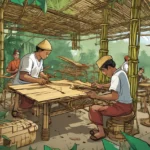Jhansi, a historical city in Uttar Pradesh, has long been associated with valour, heritage, and resilience. Known for its pivotal role in India’s struggle for independence, the city today faces the challenge of translating its historical significance into sustainable economic growth. As Jhansi works toward modernization, the key question arises: Are we fostering inclusive economic growth that benefits all segments of society, particularly the marginalized and underserved communities?
Economic Landscape of Jhansi
Jhansi’s economy is traditionally based on agriculture, with the majority of its population engaged in farming. However, in recent years, the city has seen an uptick in industrial activity, with the establishment of small and medium enterprises (SMEs) and a growing service sector. Key industries include textiles, handicrafts, and handlooms, with Jhansi also being recognized for its metal products and brassware, which have found markets across India and internationally.
The development of Jhansi’s Industrial Area and SIDCUL (State Infrastructure and Industrial Development Corporation of Uttar Pradesh) zone has created new job opportunities and encouraged economic diversification. The government’s push for infrastructure development, including better roads, improved power supply, and digital services, is fostering a business-friendly environment, which has attracted a variety of industries. These initiatives are intended to drive economic growth, but the challenge lies in ensuring that the benefits of this growth are widely shared among all the city’s residents.
Inclusivity in Development Plans
While Jhansi has made progress in industrialization, questions remain about how inclusive the development is. The state’s focus has largely been on infrastructure and industrial development, but have these changes reached the poorest sections of society? Many of the economic benefits are concentrated in urban areas, leaving rural and underserved populations with limited access to the opportunities created by industrialization.
The National Rural Employment Guarantee Scheme (NREGS) has played an important role in providing jobs in rural Jhansi, offering short-term relief to those affected by unemployment. However, economic experts argue that a more sustainable model of growth is needed—one that focuses on providing not only jobs but also the necessary skills to ensure long-term prosperity. Skill development programs and vocational training are essential to empower people to take advantage of economic opportunities created by industries and improve their employability.
Agriculture and Rural Development
Jhansi’s predominantly agrarian economy still remains deeply rooted in the countryside, with farming being the primary occupation for a large portion of the population. Although agriculture continues to be a backbone of the city’s economy, farmers often struggle with issues such as low productivity, inadequate irrigation facilities, and fluctuating market prices.
To address these concerns, the state government has launched several initiatives to modernize agriculture, including schemes aimed at improving irrigation, providing subsidies for agricultural inputs, and promoting organic farming. Despite these efforts, the benefits of these programs have not always reached the most marginalized farmers, particularly those with small landholdings. To foster more inclusive growth, it is vital that these initiatives are better tailored to the needs of the most vulnerable farming communities, ensuring that they have access to resources, technology, and market linkages that can boost their productivity and incomes.
Women’s Empowerment and Social Inclusion
An often-overlooked aspect of economic development is the empowerment of women, who constitute a significant portion of Jhansi’s population. Although the city has seen some progress in improving women’s participation in the workforce, there is still a wide gender gap when it comes to economic opportunities. In many areas, women have limited access to formal education, skill training, and credit facilities, which restricts their ability to contribute to economic development.
Initiatives such as the Pradhan Mantri Mudra Yojana (PMMY), which provides microfinance to small entrepreneurs, have helped some women establish businesses. Moreover, self-help groups (SHGs) have empowered women by allowing them to pool resources and access micro-loans. These programs are crucial in promoting social inclusion and ensuring that women have an equal stake in the city’s economic growth. However, more targeted policies are needed to address the specific barriers that women face in accessing economic opportunities, such as unequal access to resources and social biases.
Education and Skill Development
The issue of education and skill development is at the heart of fostering inclusive economic growth. While Jhansi has made strides in improving educational facilities, particularly through the establishment of institutions like Bundelkhand University, there remains a significant gap in quality education and vocational training. A large portion of the population, especially in rural areas, lacks access to higher education and specialized skills, which are crucial for competing in today’s globalized job market.
Government initiatives like Skill India and Deen Dayal Upadhyaya Grameen Kaushalya Yojana (DDU-GKY) are helping bridge the gap by providing vocational training to youth, particularly in rural areas. However, a concerted effort is needed to ensure that these programs are accessible to all, especially marginalized communities, and that they lead to meaningful employment. More collaborations between the government, industry, and educational institutions can help align training with the demands of the job market, ensuring that youth are prepared for the opportunities in sectors such as technology, manufacturing, and service.
Infrastructure Development and Urbanization
Infrastructure is a key driver of economic growth, and Jhansi has made significant investments in improving its urban infrastructure. Projects aimed at enhancing transportation, electricity, and water supply systems are critical to supporting the city’s growing population and businesses. The Atal Mission for Rejuvenation and Urban Transformation (AMRUT) and Smart Cities Mission have been instrumental in bringing about these changes.
However, while urban areas benefit from these improvements, rural Jhansi often lags behind in terms of access to quality infrastructure and services. To foster more inclusive growth, it is essential that infrastructure projects be equally focused on rural areas, ensuring that they have access to basic amenities and are connected to the economic opportunities emerging in urban centers.
The Way Forward
To achieve inclusive growth, Jhansi must focus on ensuring that the benefits of economic development reach all sections of society, especially marginalized communities. Policymakers must prioritize inclusive agricultural reforms, skill development, women’s empowerment, and access to quality education. Moreover, urban and rural areas must be integrated into the broader development framework, ensuring that both benefit from infrastructural improvements.
In conclusion, while Jhansi has made strides in its economic development, fostering truly inclusive growth requires targeted interventions that prioritize the needs of vulnerable and underserved communities. Only by addressing these disparities can Jhansi ensure a sustainable and equitable future for all its residents.








